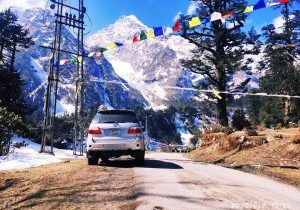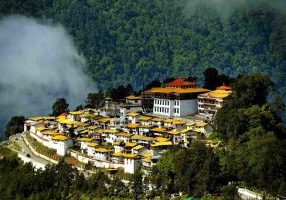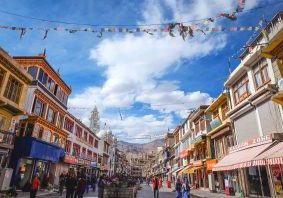In the northeastern corner of Tamil Nadu on the Bay of Bengal, Chennai (still commonly referred to by its former British name, Madras) is India’s fourth largest city, with a population nudging ten million. Hot, congested and noisy, it’s the major transport hub of the south and a tourist destination in its own right. The attractions of the city are diverse; it boasts fine specimens of Raj architecture, pilgrimage sites connected with the apostle, Doubting Thomas, superb Chola bronzes at its state museum, and plenty of classical music and dance performances.
PLACES TO VISIT IN THIS REGION
Geographically, Chennai divides into three main sectors. North of the River Cooum stands Fort St George, site of the first British outpost in India, and George Town, the commercial centre, which developed during British occupation. George Town’s principal landmark is Parry’s Corner, located at the southern end of Rajaji Salai. Sandwiched between the Cooum and Adyar rivers is central Chennai, the modern, commercial heart of the metropolis, crossed and served by the city’s main thoroughfare, Anna Salai. East of Anna Salai is the atmospheric old Muslim quarter of Triplicane and beyond is the long straight Marina with its massive beach, fishing boats and hordes of domestic tourists, saris and trousers hitched up, enjoying a paddle. Further south along the coast is the district of Mylapore, inhabited by the Portuguese in the 1500s, with its two important places of pilgrimage and tourist attractions, Kapalishvara Temple and San Thomé Cathedral.
Accommodation in Chennai
Finding an inexpensive place to stay in Chennai can sometimes be a problem. With the 24hr check-out system, it’s difficult to predict availability and some of the cheaper places don’t take advance bookings. The good news is that standards in the cheapies are better than in other cities. Most of the mid-range and inexpensive hotels are around the railway station in Egmore and further east in Triplicane. The bulk of the top hotels are in the south of the city and several offer courtesy buses to and from the airport.
Eating in Chennai
Chennai offers the complete range of dining options you would expect from a major city, ranging from dirt-cheap vegetarian “meals” joints to high-class Westernized hotel restaurants, with some unique independent venues in between.
Make sure you don't miss Saravana Bhavan. This famous south Indian fast-food chain is an institution among the Chennai middle class, with more than twenty branches dotted around the city, plus more statewide and international locations. Try one of their many thalis and finish with freshly made ladoo or barfi from their sweets counter.
Getting around Chennai
Chennai’s sights and facilities are spread over such a wide area that it’s impossible to get around without using some form of public transport. Most visitors jump in auto-rickshaws, but outside rush hours you can travel around comfortably by bus or on the suburban train. At the time of writing, the section of the new Chennai metro between Koyambedu and Alandur was up and running, as was the line from Little Mount to the airport.
Chennai drinking and nightlife
Chennai’s bar and club scene has been growing along with the disposable income of the local middle class. Triplicane, however, is almost dry and Egmore doesn’t offer much, so most of the major nightspots are located in the top-end hotels dotted around the south side of the city. Expect cover charges including a drink of up to ₹1000 per person. Check out whatshot.in/chennai for the latest trends.
Tours around Chennai
One good way to get around the sights of Chennai is on a TTDC bus tour. They’re good value, albeit rushed, and the guides can be very helpful. The TTDC half-day tour takes in Fort St George, the Government Museum (Birla Planetarium on Fri), the Snake Park, Kapalishvara Temple, and Marina Beach. TTDC also offer good-value day-trips, including visits to Mamallapuram, Kanchipuram, and Puducherry, with meals included in the tariff; check at their office at 2 Wallajah Rd, Triplicane, or on their website, for other itineraries and further details.
Fort St George
Fort St George is quite unlike any other fort in India. Facing the sea amid state offices, it looks more like a complex of well-maintained colonial mansions than a fort. Many of its buildings are today used as offices and are a hive of activity during the week. The fort was the first structure of Madras town and the first territorial possession of the British in India. Construction began in 1640 but most of the original buildings were damaged during French sieges replaced later that century. The most imposing structure is the slate-grey-and-white eighteenth-century colonnaded Fort House.
The modestly proportioned Exchange Building houses the excellent Fort Museum. The collection within faithfully records the central events of the British occupation of Madras with portraits, regimental flags, weapons, East India Company coins, medals, stamps and thick woollen uniforms that make you wonder how the Raj survived as long as it did.
Fort Museum
The modestly proportioned Exchange Building houses the excellent Fort Museum. The collection within faithfully records the central events of the British occupation of Madras with portraits, regimental flags, weapons, East India Company coins, medals, stamps and thick woollen uniforms that make you wonder how the Raj survived as long as it did. The first floor is now an art gallery, where portraits of prim officials and their wives sit side by side with fine sketches of the British embarking at Chennai in aristocratic finery, attended by Indians in loincloths. Also on display are etchings by the famous artist Thomas Daniell, whose work largely defined British perceptions of India at the end of the eighteenth century.
St Mary’s Church
South of the Fort Museum, past the State Legislature, stands the oldest surviving Anglican church in Asia, St Mary’s, built in 1678 and partly renovated after the battle of 1759. It’s distinctly English in style, crammed with plaques and statues in memory of British soldiers, politicians and their wives. The grandest plaque, made of pure silver, was presented by Elihu Yale, former governor of Fort St George (1687–96) and founder of Yale University. A collection of photographs of visiting dignitaries, including Queen Elizabeth II, is on display in the entrance porch.
George Town
North of Fort St George, the former British trading centre of George Town remains the focal area for banks, offices, shipping companies and street stalls. This network of streets harbours a fascinating medley of architecture: eighteenth- and nineteenth-century churches, Hindu and Jain temples and a scattering of mosques, interspersed with grand mansions. In the east, on Rajaji Salai, the General Post Office occupies a robust earth-red Indo-Saracenic building constructed in 1884. George Town’s southern extent is marked by the bulbous white domes and sandstone towers of the High Court and the even more opulent towers of the Law College, both showing strong Islamic influence.
Government Museum
The Chennai Government Museum contains some remarkable archaeological finds from south India and the Deccan. Inside the deep-red, circular main building, built in 1851, the first gallery is devoted to archaeology and geology; the highlights are the dismantled panels, railings and statues from the second-century AD stupa complex at Amaravati. These sensuously carved marble reliefs of the Buddha’s life are widely regarded as the finest achievements of early Indian art.
The museum’s real treasure trove, however, is the modern wing, which contains the world’s most complete and impressive selection of Chola bronzes. Large statues of Shiva, Vishnu and Parvati stand in the centre, flanked by glass cases containing smaller figurines, including several sculptures of Shiva as Nataraja, the Lord of the Dance, encircled by a ring of fire. One of the finest models is Ardhanarishvara, the androgynous form of Shiva (united with Shakti in transcendence of duality). Elsewhere, the magnificent Indo-Saracenic art gallery houses old British portraits of figures such as Clive and Hastings, plus Rajput and Mughal miniatures, and a small display of ivory carvings.
Chennai Marina
One of the longest city beaches in the world, the Marina (Kamaraj Salai) stretches 5km from the harbour at the southeastern corner of George Town to near San Thomé Cathedral. Going south, you’ll pass the Indo-Saracenic Presidency College (1865–71), one of a number of stolid Victorian buildings that make up the University, as well as adjacent Vivekananda House.
Today the beach itself is a sociable stretch, peopled by idle paddlers, picnickers and pony-riders; every afternoon crowds gather around the beach market. However, its location, just a little downstream from the port, which belches out waste and smelly fumes, combined with its function as the toilet for the fishing community, detract somewhat from its natural beauty.
Little Mount Caves and St Thomas Mount
St Thomas is said to have sought refuge from persecution in the Little Mount Caves, 8km south of the city centre. Entrance to the caves is beside steps leading to a statue of Our Lady of Good Health. Inside, next to a small natural window in the rock, are impressions of what are believed to be St Thomas’ handprints, created when he made his escape through this tiny opening. Behind the new circular church of Our Lady of Good Health is a natural spring. Tradition has it that this was created when Thomas struck the rock, so the crowds that came to hear him preach could quench their thirst; samples of its holy water are on sale.
It’s said that St Thomas was speared to death while praying before a stone cross on St Thomas Mount, 11km south of the city centre. Our Lady of Expectation Church (1523), at the summit of the Mount, can be reached by 134 granite steps marked with the fourteen stations of the Cross, or by a road which curls its way to the top, where a huge old banyan tree provides shade for devotees who come to fast, pray and sing. Inside the church, St Thomas’ cross is rumoured to have bled in 1558, while the altar is said to mark the exact spot of the apostle’s death; the painting of the Madonna and Child above the altar is attributed to St Luke.
Mylapore
Long before Madras came into existence, Mylapore, south of the Marina, was a major settlement; the Greek geographer Ptolemy mentioned it in the second century AD as a thriving port. During the Pallava period (fifth to ninth centuries) it was second only to Mamallapuram. Its two outstanding sights are venerable San Thomé Cathedral and the mighty Kapalishvara Temple, while the Sri Ramakrishna Math also warrants a visit.
Top image: Beautiful view of the Hindu Kapaleeshwarar Temple, Chennai, Tamil Nadu, South India © Jayakumar/Shutterstock
Little Mount Caves and St Thomas Mount
St Thomas is said to have sought refuge from persecution in the Little Mount Caves, 8km south of the city centre. Entrance to the caves is beside steps leading to a statue of Our Lady of Good Health. Inside, next to a small natural window in the rock, are impressions of what are believed to be St Thomas’ handprints, created when he made his escape through this tiny opening. Behind the new circular church of Our Lady of Good Health is a natural spring. Tradition has it that this was created when Thomas struck the rock, so the crowds that came to hear him preach could quench their thirst; samples of its holy water are on sale.
It’s said that St Thomas was speared to death while praying before a stone cross on St Thomas Mount, 11km south of the city centre. Our Lady of Expectation Church (1523), at the summit of the Mount, can be reached by 134 granite steps marked with the fourteen stations of the Cross, or by a road which curls its way to the top, where a huge old banyan tree provides shade for devotees who come to fast, pray and sing. Inside the church, St Thomas’ cross is rumoured to have bled in 1558, while the altar is said to mark the exact spot of the apostle’s death; the painting of the Madonna and Child above the altar is attributed to St Luke.




